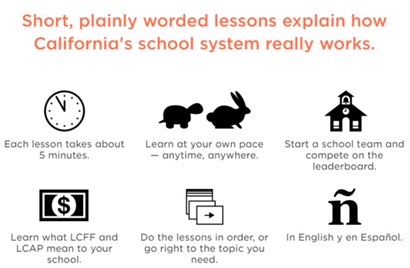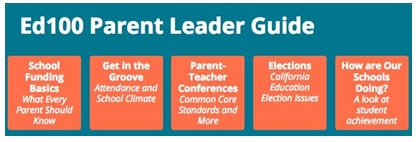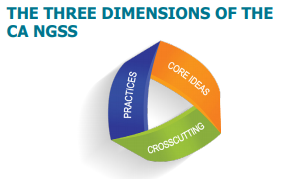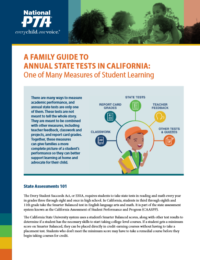Take Action Tag: Education
Student Assessments
State tests are an objective way of showing how well students met the expectations of the grade level. They are only one of many measures and aren’t meant to tell the whole story of a student’s performance. They should be combined with other information, such as report card grades, classwork and teacher observations to give families a more complete picture of their child’s academic performance.
In California, students in third through eighth and 11th grade take the Smarter Balanced test in English language arts and math. It is part of the state assessment system known as the California Assessment of Student Performance and Progress (CAASPP).
Depending on school calendars, testing in English Language Arts, mathematics, and science takes place mostly in April and May. Parents should receive their children’s reports soon after testing in their district is completed.
SMARTER BALANCED STATE ASSESSMENTS
The Smarter Balanced state assessment is focused on grade level material and is aligned to the state standards. The test questions match what students do and learn in the classroom everyday throughout the year, which are the skills that are most important for students to learn in order to move on to more challenging content.
The Smarter Balanced test is taken online and is computer adaptive, which means it adjusts the difficulty of the questions based on the student’s responses. The test includes a variety of different types of questions, including traditional multiple choice, ones that ask students to show their work and explain their answer, and questions that ask students to analyze text and write a well-developed essay. California teachers have worked closely with the state to write and review test questions.
PTA FAMILY GUIDE TO THE ANNUAL STATE TEST
National PTA developed the Family Guide to the Annual State Test which includes general information about the Smarter Balanced test, including grades and subjects tested, how the results are used and links to additional resources.
SCORE REPORTS: WHAT YOU NEED TO KNOW
The score report gives families information on how well their child performed on different sets of skills in each subject. Families can use this information to identify where their child is doing well and where they may need support or practice. This helps families better support learning at home. It can also help them to start meaningful conversations with teachers, to set goals for each student’s areas of improvement and to identify resources and strategies that can be used at home and in school to help students make progress.
- The CAASPP assessment report uses four achievement levels: standard not met, standard nearly met, standard met, standard exceeded. The levels designate the degree of “progress toward mastery of the knowledge and skills needed for success in future coursework.” For 11th-graders, they measure the degree to which students are on track to be ready for college or a career after graduating from high school.
- The scores help improve learning for your child. Scores give teachers the opportunity to adjust instruction and give students and parents an idea of which areas should get extra attention each school year and which areas students have mastered.
- Like progress on a growth chart, the tests, scores and expectations change with your child’s age and grade. As children grow and change, so do the educational standards and related assessments. Although you can see growth from year to year, scores can’t be directly compared to prior years, which measured different grade standards.
- The scores are just one measure of how your child is doing. These new tests are part of an overall system of assessment including classroom assignments, quizzes, report cards and more.
- Ask questions! The score reports generally go to parents before a new school year starts. Parents can start discussions on the score reports with their child’s teacher during back-to-school season and during parent-teacher conferences and other meetings.
ADDITIONAL RESOURCES
¡Bienvenidos!
Cada niño, una sola voz
Cada niño, una sola voz. Con más que 750,000 miembros, la mision de la associacion de padres y maestros (PTA por sus siglos en ingles) de California es de impactar positivamente las vidas de todos los ninos y las familias. La PTA se enfoca en cuatro areas principales: educacion, salud, participacion de los padres y asuntos comunitarios.
PTA trabaja para dar fuerzas a todos los padres y cree que juntos podemos hacer una realidad el potencial de cada niño. Te invitamos a utilizar nuestros recursos, ayudarnos a identificar otras nuevas, y háganos saber cómo podemos mejorar nuestra información y herramientas para mejor apoyar a ustedes como padres.
“Sabías?”
Desde del ano 1897, PTA ha sido instrumental en:
- Cinturones de seguridad
- La creación del educacion de Kindergarten
- Vacunas para polio
- Cascos de bicicletas
- Las Leyes de trabajo infantil
- Seguridad del autobús escolar
- El agua fluorada
- Servicios de Salud Pública
- La promulgación de un sistema de justicia de menores
- Promoción de los peligros de fumar
- Apoyo a la Familia y Ley de Licencia Médica
- Desarrollo de un sistema y clasificación de TV basado en contenido
- Una mejor sistema de financiación de las Escuelas Públicas
- La creación de programas de almuerzos calientes en las escuelas públicas
- Estandarizando las exámenes de salud y la Programa de Inmunización
¿Qué quieres para sus hijos? ¿Cómo vas a trabajar para mejorar la educación de su hijo? Sea cual sea su necesidad o interés, PTA está aquí para ayudarles.
Consejos para los padres: Temporada de regreso a la escuela
Aprende más
- El futuro le pertenece a su hijo
- Muy pronto llegaran a California los nuevos exámenes para los estudiantes
- Ayude a su estudiante sacar el mayor provecho de la tarea
- Consejos para los padres
- Derechos Legales de los Padres
- LCAPs: La Planificación Para El Éxito
Ed100
California’s education system is changing fast. You want to help. Learn how it all fits together with Ed100!
California State PTA and Ed100.org teamed up to help parents learn more about education so you can help create better schools.
Explore the education system in easy-to-understand language. No jargon. No partisan slant. Written by education experts who know Sacramento and local schools.
Ed100 is a free online resource that prepares you to make a difference in your school or school district. It helps you learn what you need to know to be informed, credible and ready for action.

Every California child deserves a great education. With Ed100, you can be part of the solution.
RESOURCES FOR YOUR PARENT MEETINGS
Ed100 Parent Leader Guide
The Parent Leader Guide provides “ready-to-go” plans for parent meetings. We want to help you hold meetings that matter. It’s all here: Lessons, discussion prompts, handouts and suggestions for taking action.

Arts Engagement
Unfortunately, fewer than half of all students in California get any kinds of arts education, despite it being mandated in our state education code. California falls well below the national average in terms of numbers of students receiving any kind of arts instruction. This puts our students at a disadvantage both academically and professionally, and they deserve better.
There are things you can do to support arts education, and help put California back on top!
STEPS YOU CAN TAKE TO IMPROVE ARTS EDUCATION
Here are 15 ways to improve arts education in California, grouped by the level of commitment each requires:
|
GOT A MINUTE OR TWO? |
GOT AN HOUR OR TWO? |
GOT A DAY OR TWO? |
|
|
|
WHY IS ARTS EDUCATION IMPORTANT?
 Research shows that learning arts subjects alongside math, history, science and English has an exponential effect on student success. For example, students who have an arts education achieve more A grades (in all subjects), have better attendance, are more likely to graduate from high school, and have better critical thinking, collaboration and social-emotional skills than those who don’t. This is especially true for English language learners and students from low-income backgrounds.
Research shows that learning arts subjects alongside math, history, science and English has an exponential effect on student success. For example, students who have an arts education achieve more A grades (in all subjects), have better attendance, are more likely to graduate from high school, and have better critical thinking, collaboration and social-emotional skills than those who don’t. This is especially true for English language learners and students from low-income backgrounds.
The good news continues even after high school. Kids with an arts education are more likely to graduate from college, and are more likely to pursue a professional career. Creative arts learning also boosts chances for employment once kids become adults and move into the working world: 72% of business leaders – across all industries – say that creativity is the #1 skill they are seeking, and one out of every 10 jobs in California is in a creative industry.
ARTS EDUCATION MAKES A DIFFERENCE!
Be sure to watch this video from the California Alliance for Arts Education on how arts education is being implemented in Chula Vista – and making a difference in the lives of children.
STEAM/Next Gen Science
“STEM” stands for Science, Technology, Engineering, and Mathematics education. Add Art and you have “STEAM.”
Is it STEM or STEAM? The opinions on that aren’t unanimous, but most parents and families agree about the end goal – that school curriculum should foster innovation, develop 21st century skills, and teach young people to think both logically and creatively.
Today, the fastest growing job sectors are related to science, technology, engineering, arts and math (STEAM) and 60% of college majors require a math background. Smart phones, computer-equipped cars and self-regulating appliances are just a few reminders of how pervasive technology is in our lives. We also know more technology-driven change will occur during the lifetime of our children.
STEAM LEARNING: A PRIORITY FOR OUR KIDS’ SUCCESS

It’s clear that young people with competency in the STEAM disciplines are more likely to prosper both in their lives and in their careers.
Building the capacity of young people in science, technology, engineering and math — and doing so within the humanistic frame that the arts help provide — is essential. Young people will need a high level of STEAM literacy to make decisions about their daily lives and to fulfill their role as informed citizens.
Today’s young people are already finding that more and more jobs require proficiency in STEAM disciplines. Our schools need to make sure they’re prepared.
California State PTA took particular interest in STEM/STEAM education with the 2011 passage of the resolution “Science, Technology, Engineering and Mathematics (STEM) Education” resolution and PTA has advocated for bills and policies related to STEM education many times since.
Families Are an Important Part of the STEAM Equation
Research from National PTA emphasizes the essential role of family engagement in increasing students’ access to opportunities in science, technology, engineering, arts and math — especially among girls and under-represented youth. Read the STEAM White Paper.
Five Tips for Parents
- Make It Real – Connect math and science to the real world in your everyday activities as a family. When you go to a store, bank or restaurant, talk about how math is used on bills, deposit slips, menus or for tipping. At the park or beach, observe wildlife and plants, let your child draw what he or she sees and go online at home to discover even more.
- Play Games – Encourage your child to play with puzzles and games that involve decision-making or strategy to build reasoning skills. Card games like “Go Fish” teach children to count, sort and use strategy. Games like Scrabble involve spelling and math. Playing games in the car that estimate distance or listening to music, audio books and podcasts help grow STEAM skills.
- Feed Curiosity – Borrow science, technology, art and math books and materials from the library and explore these topics online. Visit science museums, zoos, aquariums, theaters and state parks to discover what excites and interests your child. Talk with teachers about your child’s studies to find out ways to reinforce STEAM skills at home.
- Encourage Discovery – Teach children how to find information and encourage them to solve science and math problems on their own. As a child tries to solve a problem, ask helpful questions and let him/her take time to find out how to do it. Learning how to find answers helps to develop critical thinking.
- Expand Horizons – While young children may want to be doctors or firefighters, widen their awareness of other interesting careers. Pilots, mechanics, software engineers, forest rangers, video-game developers and biologists, for instance, are all jobs requiring STEAM skills. Go online together to explore the range of career options available with a foundation in STEAM.
NEXT GENERATION SCIENCE STANDARDS
Science is the S in STEAM — the acronym now often used when people want to talk about science, technology, engineering, art and math as a set of connected school subjects.
California schools are taking a new approach to science, thanks to the state’s adoption of the Next Generation Science Standards (NGSS). The standards call on schools to introduce science to students beginning in kindergarten in order to fuel kids’ innate curiosity and ignite a lifelong interest in science and engineering. That’s especially important for students who don’t think of themselves as “science kids.”
When educators talk about NGSS they may mention “three dimensional learning.” 
- Dimension 1: Science and Engineering Practices (SEPs) – What scientists and engineers do. SEPs are skills and behaviors they use to answer a question or solve a problem.
- Dimension 2: Disciplinary Core Ideas – What scientists and engineers know. These fundamental ideas are organized into four disciplines: life science; physical science; Earth and space science; and engineering, technology, and applications of science.
- Dimension 3: Crosscutting Concepts – How scientists and engineers think. Understanding these common threads that tie together the four disciplines of science helps students deepen their understanding of core ideas and allows them to implement the practices more effectively.
Building Knowledge and Understanding Over Time
Here is an example of what a child might experience in science as they go through school. Earth’s Systems is the NGSS “Disciplinary Core Idea” being taught.
- Kindergarten: Students begin looking for patterns in weather through their own personal observations
- 3rd grade: Students use actual data in tables and graphical displays to describe typical weather conditions expected during a particular season and climate change over time
- Middle school: Students collect data to provide evidence for how the motions and complex interactions of air masses result in changes in weather conditions
- High school: Students use a model to describe how variations in the flow of energy into and out of Earth’s systems result in changes in climate.
As young people get older, they learn progressively more about the topic of weather while they also develop their ability to use scientific practices such as data collection and analysis. Even in kindergarten, they begin gaining familiarity with crosscutting concepts — such as patterns and stability versus change — that are used in every science domain.
At every grade level, this new approach to teaching science is designed to be more engaging and interactive, aligning with how kids learn best. The new standards encourage students to ask lots of questions and emphasize hands-on investigation and discovery. The new standards will also allow teachers to be more innovative and creative in the ways they teach science.
PARENTS KNOW SCIENCE IS IMPORTANT

In a PTA-sponsored survey of parents throughout California, 9 out of 10 parents agreed that learning science is equally important as reading, writing and math. Parents know science matters but only about half said they were satisfied with the amount of science education their child was getting in school. Many people hope that the state’s on-going work to transform how schools teach science will help change that.
ADDITIONAL RESOURCES
- In the California State PTA Resource Library you’ll find more information about how the Next Generation Science Standards are being taught as well as great ideas for how families all over California can discover science together.
- What Your PTA Can Do to Promote STEAM Education
- Online STEAM Activities and Reference Sources
- California’s Adopted Common Core State Standards: Mathematics
- National Research Council Report on STEM Integration in K-12 Curriculum
- Research Paper: Early Exposure to STEM and Its Impact on the Future of Work
- POLICY REPORT: PTA Survey Reveals Parents’ Views on Science Education (NGSS)
